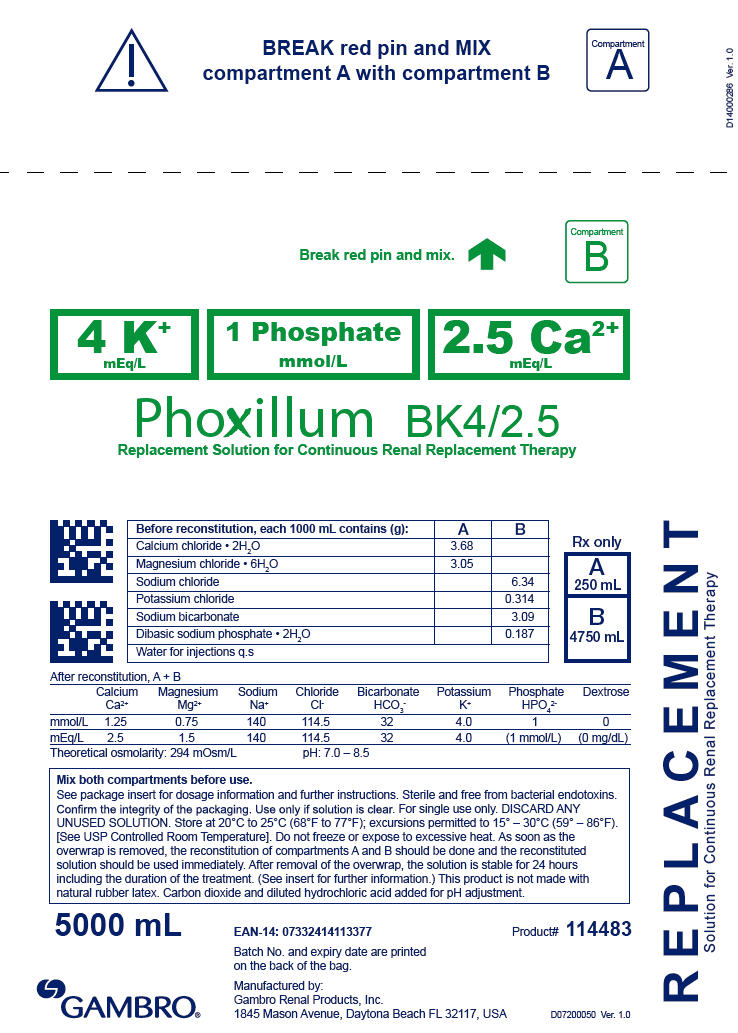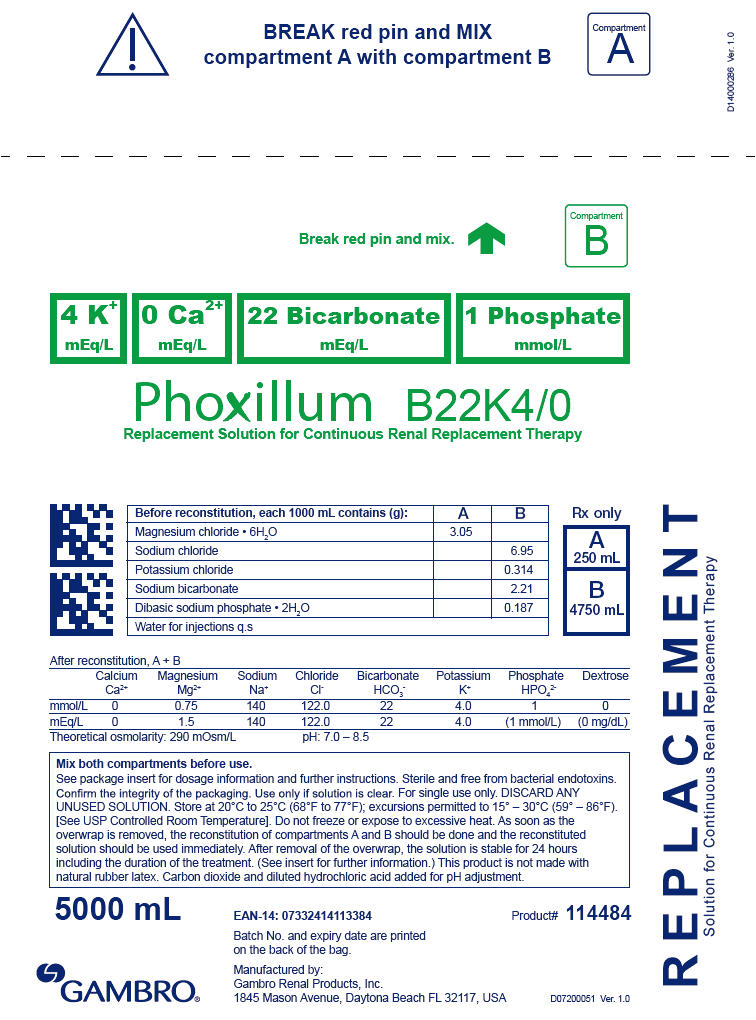PHOXILLUM BK4/2.5- calcium chloride, magnesium chloride, sodium chloride, potassium chloride, sodium phosphate, dibasic, and sodium bicarbonate solution PHOXILLUM B22K4/0- magnesium chloride, sodium chloride, potassium chloride, sodium phosphate, dibasic, and sodium bicarbonate solution
Phoxillum by
Drug Labeling and Warnings
Phoxillum by is a Prescription medication manufactured, distributed, or labeled by Gambro Renal Products. Drug facts, warnings, and ingredients follow.
Drug Details [pdf]
-
HIGHLIGHTS OF PRESCRIBING INFORMATION
These highlights do not include all the information needed to use PRISMASOL and PHOXILLUM safely and effectively.
See full prescribing information for PRISMASOL and PHOXILLUM.
PRISMASOL renal replacement solution
PRISMASOL Initial U.S. Approval: 2006
PHOXILLUM renal replacement solution
PHOXILLUM Initial U.S Approval: 2015RECENT MAJOR CHANGES
Dosage and Administration 01/2015 Warnings and Precautions 01/2015 INDICATIONS AND USAGE
PRISMASOL and PHOXILLUM solutions are indicated:
- As a replacement solution in Continuous Renal Replacement Therapy (CRRT) and in case of drug poisoning when CRRT is used to remove dialyzable substances (1)
DOSAGE AND ADMINISTRATION
DOSAGE FORMS AND STRENGTHS
CONTRAINDICATIONS
None (4)
WARNINGS AND PRECAUTIONS
- Hemodynamic status and fluid, electrolyte and acid-base balance should be monitored. Abnormalities may be corrected by the use of appropriate formulations of PRISMASOL and PHOXILLUM solutions (5.1)
- Antidiabetic therapy may need adjustment during treatment with dextrose containing formulations (5.2)
To report SUSPECTED ADVERSE REACTIONS, contact Gambro at 1-800-651-2623 or FDA 1-800-FDA-1088 or www.fda.gov/medwatch
Revised: 2/2015
-
Table of Contents
FULL PRESCRIBING INFORMATION: CONTENTS*
1 INDICATIONS AND USAGE
2 DOSAGE AND ADMINISTRATION
2.1 Administration Instructions
2.2 Dosing Considerations
2.3 Preparing the Solution
2.4 Adding Drugs to the Solutions
3 DOSAGE FORMS AND STRENGTHS
4 CONTRAINDICATIONS
5 WARNINGS AND PRECAUTIONS
5.1 Electrolyte and Volume Abnormalities
5.2 Hyperglycemia with Dextrose Containing Solutions
7 DRUG INTERACTIONS
7.1 Citrate
8 USE IN SPECIFIC POPULATION
8.1 Pregnancy
8.3 Nursing Mothers
8.4 Pediatric Use
8.5 Geriatric Use
11 DESCRIPTION
12 CLINICAL PHARMACOLOGY
12.1 Mechanism of Action
12.3 Pharmacokinetics
16 HOW SUPPLIED/STORAGE AND HANDLING
- * Sections or subsections omitted from the full prescribing information are not listed.
-
1 INDICATIONS AND USAGE
PRISMASOL and PHOXILLUM solutions are indicated in pediatric and adult patients for use as a replacement solution in Continuous Renal Replacement Therapy (CRRT) to replace plasma volume removed by ultrafiltration and to correct electrolyte and acid-base imbalances.They may also be used in case of drug poisoning when CRRT is used to remove dialyzable substances.
-
2 DOSAGE AND ADMINISTRATION
2.1 Administration Instructions
Visually inspect PRISMASOL and PHOXILLUM for particulate matter and discoloration prior to administration.
Administration should only be under the direction of a physician competent in intensive care treatment including CRRT. Use only with extracorporeal dialysis equipment appropriate for CRRT.
The prepared solution is for single patient use only.
Aseptic technique should be used throughout administration to the patient.
Discard any unused solution.
2.2 Dosing Considerations
PRISMASOL replacement solutions contain 4 different combinations of active ingredients (8 different products with varying ingredient amounts). PHOXILLUM replacement solutions contain 2 different combinations of active ingredients (2 different products with varying ingredient amounts). PRISMASOL and PHOXILLUM are supplied in a two-compartment bag that must be mixed immediately prior to use [see Dosage and Administration (2.3)]:
- Small compartment A (250 mL) containing an electrolyte solution, and
- Large compartment B (4750 mL) containing the buffer solution.
See Table 1 for the concentrations of the active ingredients (after mixing) in these 10 different replacement solutions (total volume is 5 Liters).
Table 1: Concentrations of Active Ingredients in the 8 PRISMASOL and 2 PHOXILLUM Replacement Solutions after Mixing Ca2+
mEq/LHCO3-
mEq/LK+
mEq/LMg2+
mEq/LNa+
mEq/LHPO42-
mmol/LCl-
mEq/LLactate
mEq/LDextrose
mg/dLOsmolarity
mOsm/LCa2+ = calcium, HCO3- = bicarbonate, K+ = potassium, Mg2+ = magnesium, Na+ = sodium, HPO42- = phosphate, Cl- = chloride; osmolarity is estimated PRISMASOL Replacement Solutions BGK0/2.5 2.5 32 0 1.5 140 0 109.0 3.0 100 292 BGK4/2.5 2.5 32 4.0 1.5 140 0 113.0 3.0 100 300 BGK4/3.5 3.5 32 4.0 1.0 140 0 113.5 3.0 100 300 BGK2/3.5 3.5 32 2.0 1.0 140 0 111.5 3.0 100 296 BGK2/0 0 32 2.0 1.0 140 0 108.0 3.0 100 291 B22GK4/0 0 22 4.0 1.5 140 0 120.5 3.0 100 296 BGK4/0/1.2 0 32 4.0 1.2 140 0 110.2 3.0 100 295 BK0/0/1.2 0 32 0 1.2 140 0 106.2 3.0 0 282 PHOXILLUM Replacement Solutions BK4/2.5 2.5 32 4.0 1.5 140 1 114.5 0 0 294 B22K4/0 0 22 4.0 1.5 140 1 122.0 0 0 290 Select the mode of therapy, solute formulation, flow rates, and length of PRISMASOL and PHOXILLIUM replacement therapy in CRRT based on the patient's clinical condition, and fluid, electrolyte, acid-base, glucose balance. Administer either PRISMASOL or PHOXILLUM into the extracorporeal circuit:
- Before (pre-dilution) the hemofilter or hemodiafilter,
- After (post-dilution) the hemofilter or hemodiafilter, or
- Before and after the hemofilter or hemodiafilter.
2.3 Preparing the Solution
Use only if the overwrap is not damaged, all seals are intact, and the solution is clear. Press bag firmly to test for any leakage. Do not use if container is damaged or leaking.
The solution may be heated to no more than 40°C/104°F inside of the overwrap. After heating, verify that the solution remains clear and contains no particulate matter.
Follow the instructions below when connecting the solution bags for correct use of the access ports
Figure 1
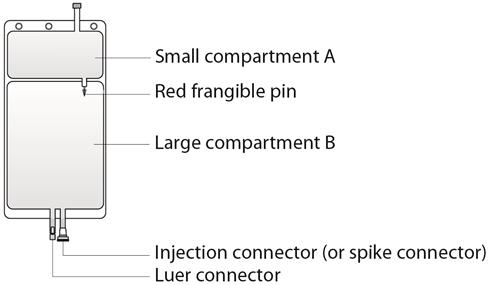
Figure 2 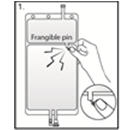
Step 1 Immediately before use, remove the overwrap from the bag and mix the solutions in the two different compartments. As soon as the overwrap is removed, the reconstitution of compartments A and B should be done and the mixed solution should be used immediately.
After removal of the overwrap, the solution is stable for 24 hours including the duration of the treatment.
Open the seal by breaking the red frangible pin between the two compartments of the bag. The frangible pin will remain in the bag. (See Figure 2 beside)Figure 3 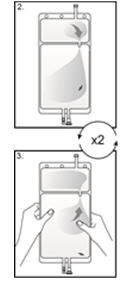
Step 2 Make sure all the fluid from the small compartment A is transferred into the large compartment B. (See Figure 3 beside) Step 3 Rinse the small compartment A twice by pressing the mixed solution back into the small compartment A and then back into the large compartment B. (See Figure 3 beside) Figure 4 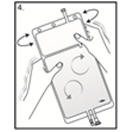
Step 4 When the small compartment A is empty, shake the large compartment B so that the contents mix completely. (See Figure 4 beside)
The solution is now ready to use and the bag can be hung on the equipment.Figure 5a 
Step 5 The replacement line may be connected to the bag through either the luer connector or the injection connector (spike connector).
Step 5a The luer connector is a needle-less and swabbable connector. Remove the cap with a twist and pull motion, and connect the male luer lock on the replacement line to the female luer receptor on the bag. (See Figure 5a beside)
Ensure that the connection is fully seated and tighten. The connector is now open. Verify that the fluid is flowing freely during use.
When the replacement line is disconnected from the luer connector, the connector will close and the flow of the solution will stop.Figure 5b 
Step 5b If the injection connector (spike connector) is used, first remove the snap-off cap. Then introduce the replacement line spike through the rubber septum of the bag connector. (See Figure 5b beside)
Ensure that the spike is fully inserted and verify that the fluid is flowing freely during use.2.4 Adding Drugs to the Solutions
After mixing, additional drugs may be added to the bag via injection connector (spike connector) in large compartment B. In general, drugs other than phosphate should be administered through a different access line. When introducing additives, use aseptic techniques.
-
3 DOSAGE FORMS AND STRENGTHS
See Table 1 for the concentrations of the active ingredients (after mixing) in these 10 different replacement solutions [see Dosage and Administration (2.2)].
- 4 CONTRAINDICATIONS
-
5 WARNINGS AND PRECAUTIONS
5.1 Electrolyte and Volume Abnormalities
Monitor hemodynamic status and fluid, electrolyte and acid-base balance throughout the procedure. During hemofiltration or hemodiafiltration using PRISMASOL or PHOXILLUM replacement solutions, abnormalities in the plasma concentration of potassium, calcium, magnesium, and phosphate may develop. These abnormalities may be corrected by changing the formulations of replacement solution or by supplementation [see Dosage and Administration (2)].
5.2 Hyperglycemia with Dextrose Containing Solutions
The use of PRISMASOL replacement solutions containing dextrose may increase the risk for hyperglycemia in patients with impaired glucose tolerance. Patients may require initiation of or modification of antidiabetic therapy during treatment with PRISMASOL solutions containing dextrose. Monitor blood glucose.
- 7 DRUG INTERACTIONS
-
8 USE IN SPECIFIC POPULATION
8.1 Pregnancy
Pregnancy Category C
Animal reproduction studies have not been conducted with PRISMASOL and PHOXILLUM solutions. While there are no adequate and well controlled studies in pregnant women, appropriate administration of PRISMASOL and PHOXILLUM solutions with monitoring of fluid, electrolyte, acid-base and glucose balance, is not expected to cause fetal harm, or affect reproductive capacity. Maintenance of normal acid-base balance is important for fetal well-being.
8.3 Nursing Mothers
The components of PRISMASOL and PHOXILLUM solutions are excreted in human milk. Appropriate administration of PRISMASOL and PHOXILLUM solutions with monitoring of fluid, electrolyte, acid-base and glucose balance, is not expected to harm a nursing infant.
-
11 DESCRIPTION
PRISMASOL and PHOXILLUM solutions are clear, sterile, free of bacterial endotoxins and contain no bacteriostatic or antimicrobial agents. These solutions are used in Continuous Renal Replacement Therapies (CRRT) as a replacement solution in hemofiltration and hemodiafiltration. Depending on the product (see Table 2), the two compartments contain:
Calcium chloride, USP, is chemically designated calcium chloride dihydrate (CaCl2 ∙ 2H2O).
Magnesium chloride, USP, is chemically designated magnesium chloride hexahydrate (MgCl2 ∙ 6H2O).
Sodium chloride, USP, is chemically designated NaCl.
Potassium chloride, USP, is chemically designated KCl.
Sodium bicarbonate, USP, is chemically designated NaHCO3.
Dextrose, USP, is chemically designated D-Glucose anhydrous (C6H12O6) or D-Glucose monohydrate (C6H12O6 ∙ H2O).
Lactic acid, USP, is chemically designated CH3CH(OH)COOH.
Dibasic sodium phosphate, USP, is chemically designated as disodium hydrogen phosphate, dihydrate (Na2HPO4 ∙ 2H2O)
TABLE 2 – Compartment Composition (Before Mixing) Compartment A (g/L) Compartment B (g/L) Calcium Chloride ∙ 2H2O Magnesium Chloride ∙ 6H2O Dextrose anhydrous (as monohydrate) Lactic Acid Sodium Chloride Sodium bicarbonate Potassium Chloride Sodium Phosphate ∙ 2H2O PRISMASOL SOLUTIONS BGK 0/2.5 3.68 3.05 20.0 (22.0) 5.40 6.46 3.09 0 0 BGK 4/2.5 3.68 3.05 20.0 (22.0) 5.40 6.46 3.09 0.314 0 BGK 4/3.5 5.15 2.03 20.0 (22.0) 5.40 6.46 3.09 0.314 0 BGK 2/3.5 5.15 2.03 20.0 (22.0) 5.40 6.46 3.09 0.157 0 BGK 2/0 0 2.03 20.0 (22.0) 5.40 6.46 3.09 0.157 0 B22GK 4/0 0 3.05 20.0 (22.0) 5.40 7.07 2.21 0.314 0 BK 0/0/1.2 0 2.44 0 (0) 5.40 6.46 3.09 0 0 BGK 4/0/1.2 0 2.44 20.0 (22.0) 5.40 6.46 3.09 0.314 0 PHOXILLUM SOLUTIONS BK 4/2.5 3.68 3.05 0 (0) 0 6.34 3.09 0.314 0.187 B22K 4/0 0 3.05 0 (0) 0 6.95 2.21 0.314 0.187 The pH of the final solution is in the range of 7.0 to 8.5.
-
12 CLINICAL PHARMACOLOGY
12.1 Mechanism of Action
PRISMASOL and PHOXILLUM solutions are pharmacologically inactive. The electrolyte concentrations in the solutions are chosen to restore plasma levels to clinically desired concentrations or maintain plasma levels at the desired concentrations.
PRISMASOL and PHOXILLUM solutions are used as replacement solution to replace water and electrolytes removed during hemofiltration and hemodiafiltration. Bicarbonate (or precursor lactate) in the solution is used as an alkalinizing buffer to restore acid-base balance to a clinically desirable level.
12.3 Pharmacokinetics
The distribution of electrolytes, bicarbonate, and dextrose is determined by the patient's clinical condition, metabolic status, and residual renal function.
The elimination and replacement of water, electrolytes and buffer depend on the patient's electrolyte and acid-base balance, metabolic status, residual renal function and ongoing physiologic losses through intestinal, respiratory and cutaneous routes.
-
16 HOW SUPPLIED/STORAGE AND HANDLING
PRISMASOL and PHOXILLUM solutions are supplied in a two-compartment bag made of polyvinyl chloride (PVC). The 5000 mL bag is composed of a small compartment (250 mL) and a large compartment (4750 mL). The two compartments are separated by a red frangible pin.
The bag is overwrapped with a transparent overwrap. See Table 2 for the concentrations of the active ingredients in each compartment for each product [see Description (11)].
Container Fill Volume NDC PRISMASOL BGK0/2.5 5000 mL 24571-108-05 PRISMASOL BGK4/2.5 5000 mL 24571-105-05 PRISMASOL BGK4/3.5 5000 mL 24571-104-05 PRISMASOL BGK2/3.5 5000 mL 24571-103-05 PRISMASOL BGK2/0 5000 mL 24571-102-05 PRISMASOL B22GK4/0 5000 mL 24571-111-05 PRISMASOL BK0/0/1.2 5000 mL 24571-113-05 PRISMASOL BGK4/0/1.2 5000 mL 24571-114-05 PHOXILLUM BK4/2.5 5000 mL 24571-116-05 PHOXILLUM B22K4/0 5000 mL 24571-117-05 Not all formulations may be marketed.
- SPL UNCLASSIFIED SECTION
- PRINCIPAL DISPLAY PANEL - 5000 mL Bag Label - BK4/2.5
- PRINCIPAL DISPLAY PANEL - 5000 mL Bag Label - B22K4/0
-
INGREDIENTS AND APPEARANCE
PHOXILLUM BK4/2.5
calcium chloride, magnesium chloride, sodium chloride, potassium chloride, sodium phosphate, dibasic, and sodium bicarbonate solutionProduct Information Product Type HUMAN PRESCRIPTION DRUG Item Code (Source) NDC: 24571-116 Route of Administration INTRAVENOUS Active Ingredient/Active Moiety Ingredient Name Basis of Strength Strength Calcium Chloride (UNII: M4I0D6VV5M) (Calcium cation - UNII:2M83C4R6ZB, Chloride Ion - UNII:Q32ZN48698) Calcium Chloride 0.139 g in 1 L Magnesium Chloride (UNII: 02F3473H9O) (Magnesium Cation - UNII:T6V3LHY838, Chloride Ion - UNII:Q32ZN48698) Magnesium Chloride 0.071 g in 1 L Sodium Chloride (UNII: 451W47IQ8X) (Sodium Cation - UNII:LYR4M0NH37, Chloride Ion - UNII:Q32ZN48698) Sodium Chloride 6.023 g in 1 L Potassium Chloride (UNII: 660YQ98I10) (Potassium Cation - UNII:295O53K152, Chloride Ion - UNII:Q32ZN48698) Potassium Chloride 0.298 g in 1 L Sodium Phosphate, Dibasic (UNII: GR686LBA74) (Sodium Cation - UNII:LYR4M0NH37, Phosphate Ion - UNII:NK08V8K8HR) Sodium Phosphate, Dibasic 0.146 g in 1 L Sodium Bicarbonate (UNII: 8MDF5V39QO) (Sodium Cation - UNII:LYR4M0NH37, Bicarbonate Ion - UNII:HN1ZRA3Q20) Sodium Bicarbonate 2.936 g in 1 L Inactive Ingredients Ingredient Name Strength Water (UNII: 059QF0KO0R) Carbon Dioxide (UNII: 142M471B3J) Hydrochloric Acid (UNII: QTT17582CB) Packaging # Item Code Package Description Marketing Start Date Marketing End Date 1 NDC: 24571-116-05 5 L in 1 BAG; Type 0: Not a Combination Product Marketing Information Marketing Category Application Number or Monograph Citation Marketing Start Date Marketing End Date NDA NDA207026 04/01/2015 PHOXILLUM B22K4/0
magnesium chloride, sodium chloride, potassium chloride, sodium phosphate, dibasic, and sodium bicarbonate solutionProduct Information Product Type HUMAN PRESCRIPTION DRUG Item Code (Source) NDC: 24571-117 Route of Administration INTRAVENOUS Active Ingredient/Active Moiety Ingredient Name Basis of Strength Strength Magnesium Chloride (UNII: 02F3473H9O) (Magnesium Cation - UNII:T6V3LHY838, Chloride Ion - UNII:Q32ZN48698) Magnesium Chloride 0.071 g in 1 L Sodium Chloride (UNII: 451W47IQ8X) (Sodium Cation - UNII:LYR4M0NH37, Chloride Ion - UNII:Q32ZN48698) Sodium Chloride 6.603 g in 1 L Potassium Chloride (UNII: 660YQ98I10) (Potassium Cation - UNII:295O53K152, Chloride Ion - UNII:Q32ZN48698) Potassium Chloride 0.298 g in 1 L Sodium Phosphate, Dibasic (UNII: GR686LBA74) (Sodium Cation - UNII:LYR4M0NH37, Phosphate Ion - UNII:NK08V8K8HR) Sodium Phosphate, Dibasic 0.146 g in 1 L Sodium Bicarbonate (UNII: 8MDF5V39QO) (Sodium Cation - UNII:LYR4M0NH37, Bicarbonate Ion - UNII:HN1ZRA3Q20) Sodium Bicarbonate 2.1 g in 1 L Inactive Ingredients Ingredient Name Strength Water (UNII: 059QF0KO0R) Carbon Dioxide (UNII: 142M471B3J) Hydrochloric Acid (UNII: QTT17582CB) Packaging # Item Code Package Description Marketing Start Date Marketing End Date 1 NDC: 24571-117-05 5 L in 1 BAG; Type 0: Not a Combination Product Marketing Information Marketing Category Application Number or Monograph Citation Marketing Start Date Marketing End Date NDA NDA207026 04/01/2015 Labeler - Gambro Renal Products (041093923) Establishment Name Address ID/FEI Business Operations Gambro Renal Products 041093923 MANUFACTURE(24571-116, 24571-117)
Trademark Results [Phoxillum]
Mark Image Registration | Serial | Company Trademark Application Date |
|---|---|
 PHOXILLUM 86346945 4842319 Live/Registered |
GAMBRO LUNDIA AB 2014-07-24 |
© 2026 FDA.report
This site is not affiliated with or endorsed by the FDA.
